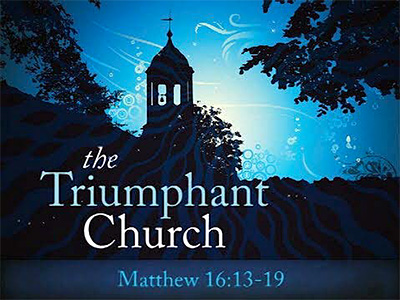The Church in Prophecy
Past, Present and Future

There is much talk going around these days about how unified, triumphant and glorious the Church will be in the end times right before the return of Jesus. This pollyanna image of the Church is certainly attractive, but it only partially corresponds with what the Bible prophesies.
But before we take a look at end time prophecies regarding the Church, let’s take a look at the Church in Bible prophecy in the past and present.
Old Testament Prophecies
Some theologians take the position that the Church is not mentioned in the Hebrew Scriptures. This is both right and wrong. It is correct that there is no specific mention of the Church. But, on the other hand, the Church is certainly intimated in a number of prophecies in the Old Testament.
The Apostle Paul referred to five of these prophetic passages in Romans 15 where he justified his preaching of the Gospel to Gentiles. He specifically quoted:
- 2 Samuel 22:50 and Psalm 18:49 — both of which speak of a time when God will be praised among the Gentiles (Romans 15:9).
- Deuteronomy 32:43 — which says a time will come when Gentiles will rejoice with the Jews (Romans 15: 10).
- Psalm 117:1 — which says there will be a day when the Gentiles will praise the God of the Jews (Romans 15:11).
- Isaiah 11:10 — which says when the Messiah comes (“the root of Jesse”), Gentiles will find hope in Him (Romans 15:12).
- Isaiah 52:15 — which says that one day the Gentiles will come to know and understand the Messiah (Romans 15: 21).
And these are only a few of the Old Testament prophecies about the future inclusion of Gentiles into God’s Plan for the Ages. Isaiah 42:1 says the Messiah will bring “justice to the nations [Gentiles]” A few verses later, Isaiah proclaims that the Messiah will be “a light to the nations [Gentiles]” (Isaiah 42:6). Isaiah repeats this prophecy in Chapter 49 where he quotes God as saying that He will make the Messiah “a light to the nations [Gentiles] so that My salvation may reach to the end of the earth” (Isaiah 49:6b).

One of my favorite prophetic references to the future inclusion of Gentiles in God’s kingdom is found in Isaiah 9:1-2 where the prophet says that one day God will make glorious the “Galilee of the Gentiles.” Specifically, he states that “the people who walk in darkness will see a great light [the Messiah].” Another is found in Isaiah 54:1 where the prophet declares that a time will come when “the sons of the desolate one [the Gentiles] will be more numerous than the sons of the married woman [Israel].”
The cornerstone prophecy about the inclusion of Gentiles in God’s plan of salvation is to be found in the Abrahamic Covenant, which is first enumerated in Genesis 12:1-3. In this passage, Abraham was told by God that through his descendants “all the families of the earth shall be blessed.” That promise certainly included the Gentiles.
Fulfillment of the Prophecies
Although it was always possible for Gentiles to be saved during Old Testament times by responding to the Creator in faith (Joel 2:32 and Romans 2:14-15), their specific inclusion in God’s Plan for the Ages did not occur until the Day of Pentecost in about 30 AD. This was when the Church was established. The Apostle Peter preached the first Gospel sermon (Acts 2:14-36), and three thousand souls responded.
It is true that all of these were Jews. It is true that the Church began with Jewish people responding to a Jewish message about a Jewish Messiah. And thus, the Church began as what appeared to be a Jewish sect. But within a few years of its establishment, the Church was opened up to Gentiles in fulfillment of Old Testament prophecies.
This began when the Apostle Peter was given a vision by God that made it clear that Gentiles were to be included in the Church (Acts 10:9-15). That same day, Peter was summoned to Caesarea Maritime to preach to a Roman soldier named Cornelius (Acts 10:19-22). When Peter shared the good news of salvation with this soldier, he and all his household received Jesus as Lord and Savior. The Holy Spirit fell on them, and they were baptized in the name of Jesus (Acts 10:34-48).
This turning-point event caused a crisis in the Church. Some questioned whether or not pagan Gentiles should be included. Others argued that if they were to be included, they must be required to submit to circumcision and the laws of the Torah.
These controversies resulted in a conference in Jerusalem where it was decided that it was God’s will to include Gentiles (Acts 15:6-29). It was also determined that Gentiles should not be compelled to become practitioners of Jewish laws. In the process, Peter quoted a prophecy from the Hebrew Scriptures that envisioned a day when “the rest of Mankind would seek the Lord,” including “all the Gentiles” (Acts 15:14-18 in reference to Amos 9:11-12).
Near the end of Paul’s second missionary journey, after his arrival in Corinth, he became upset with the persistent resistance of the Jews to the Gospel. This frustration prompted him to declare, “From now on, I shall go to the Gentiles” (Acts 18:6). And over the next few years, the whole complexion of the Church changed from a Jewish sect to a Gentile congregation.
New Testament Prophecy
The first specific mention of the Church in prophecy is found in the New Testament in Matthew 16:18 where Jesus is recorded as having said: “Upon this rock I will build My Church; and the gates of Hades shall not overpower it.” The context of this statement makes it clear that the “rock” Jesus was referring to was Peter’s confession of Him as “the Christ [Messiah], the Son of the living God” (Matthew 16:16).
This prophecy has, of course, been fulfilled throughout history since the time Jesus spoke those words. Satan has tried in every way possible to destroy the Church, first through persecution, and then through internal corruption. But Jesus has sustained His Church to this day and continues to do so today in the midst of growing apostasy and increasing worldwide persecution.

I believe Jesus prophesied rather specifically about the future of His Church in the seven letters that He dictated to the Apostle John in Revelation, Chapters 2 and 3. The letters were directed to seven churches located in the area of western Turkey today. There were many more churches than these seven. I think Jesus selected the ones He did because they were representative of seven types of churches and seven periods of church history. In each period, all seven types of churches would exist, but one type would predominate.
The church at Ephesus is representative of the apostolic period from 30 A.D. to 95 A.D., when the Church was concerned about organization and doctrine to the point that it became legalistic.
The church at Smyrna represents the persecuted church or the martyr church that existed from 95 A.D. to about 312 A.D. It’s the Church that existed at the time that the book of Revelation was written.
Then we have the liberal church of Pergamum representing the apostate church that existed from 312 to 590 A.D. This period developed after the Emperor Constantine was converted and the Church and the state were welded together. As is always the case in such unions, the state began to corrupt the Church.
The church at Thyatira represents the dark, pagan period from 590 to 1517 when the papacy developed and the Church became full of Babylonian occultic practices.
When we come to the Reformation in 1517, we think of it as a time of life. But it was only partially so. The Reformation produced the Protestant state churches of Europe — churches that had a reputation for being alive but were really dead because of their union with the state. So the church of Sardis, the dead church, with the reputation for being alive, represents the post-Reformation period from 1517 to about 1750.
The opposite of Sardis is the church at Philadelphia, the alive church. It represents the period of church history from about 1750, when the Church began to send missionaries out all over the world, until about 1900, when the German School of Higher Criticism invaded seminaries worldwide and destroyed many people’s faith in the Word of God. As a result, people began to look upon the Bible, not as the revealed Word of God, but as man’s search for God, and therefore they decided it was full of myth, legend and superstition.
The Church of today is represented by the church of Laodicea, a church that says to the world, “I am rich, and have become wealthy, and have need of nothing” (Revelation 3:17). But Jesus says to that church, “You are wretched and miserable and poor and blind and naked” (3:17). It is a worldly, apathetic, apostate church that will not even let Jesus in the front door (3:20).
The best summary of these letters I have ever encountered is the one penned by John Stott in his book, Basic Christianity. He sees the message of Jesus as threefold in nature. To a sinful Church, He is saying, “I know of your sin, repent!” To a doubtful Church, He is saying, “I know of your doubt, believe!” To a fearful Church, He is saying, “I know of your fear, endure!” Repent, believe, and endure — that’s a very relevant message for the Church today.
Negative End Time Prophecies
The predominance of the Laodicean church today is the fulfillment of many other New Testament prophecies that point to the growth of apostasy, cultism, heresy and worldliness in the Church of the end times.
Apostasy
The picture of the Church in the end times that is portrayed in the Bible is not a very pretty one. For one thing, the Bible prophesies that the Church will be racked by apostasy. Jesus prophesied that “many will fall away” (Matthew 24:10). Likewise, Paul said the Antichrist cannot be revealed until “the great apostasy” takes place (2 Thessalonians 2:3).
Paul reveals the source of the apostasy in 2 Timothy 3:5 — “Men will hold to a form of religion but will deny its power.” As pointed out above, the fulfillment of this prophecy began in the early 20th Century with the ascendancy of the German School of Higher Criticism and its teaching that the Bible should be approached like any other piece of literature — with a critical eye. The concepts of the special inspiration and inerrancy of the Bible were rejected. The Bible came to be viewed as Man’s search for God rather than God’s revelation to Man. Churches began to reject some of the fundamentals of the faith.
This assault on the integrity of God’s Word opened the floodgates of apostasy. Before long Christian theologians and ministers were laughing about the virgin birth of Jesus, discounting His miracles, casting doubt on His resurrection, and flatly denying His second coming.
As the uniqueness of Jesus was downplayed, many denominations began to embrace the damnable doctrine of Universalism. And that is where we are today, caught up in the midst of a gross apostasy which says, “Believe what you want. The important thing is to be sincere. There are many roads to God.” All of which makes a liar of Jesus who said: “I am the way, the truth and the life, no one comes to the Father except through Me” (John 14:6). The result is that there are a lot of sincere people who are sincerely going to Hell.

Cultism
A second set of prophecies warn that the Church will be assaulted by cultic deception in the end times. Jesus emphasized this point repeatedly in His Olivet Discourse (Matthew 24:5,11, 24). And Paul underlined it in the strongest possible language when he wrote: “The Spirit explicitly says that in later times some will fall away from the faith, paying attention to deceitful spirits and doctrines of demons” (1 Timothy 4:1).
The fulfillment of these prophecies began in the 19th Century with the rise of Mormonism and its demonic teaching that Jesus is the brother of Lucifer, one of thousands of gods created by the super god, Adam, an exalted man. The Jehovah’s Witnesses were next on the scene with their perverted teaching that Jesus is the Archangel Michael.
This century has witnessed the rapid multiplication of the cults, just as prophesied. Today, lifelong Christians who do not know why they believe what they profess to believe are being sucked into the cults by the tens of thousands.
Equally appalling is the direct penetration of the Church by cultic doctrine. Well known Christian leaders are advocating the ancient Shamanistic practice of visualization as the key to prayer. Others are teaching one of Satan’s oldest lies — that those who have been born again are “little gods.”
The latest cultic fad is the concept of Satanic salvation; namely, that we do not owe our salvation to the blood Jesus shed on the Cross but rather to some imaginary torment which He suffered at the hands of Satan for three days in Hell. And then, of course, there is Masonry, the oldest form of cultic penetration of the Church, with its secret blood oaths, its works salvation, and its Universalism.
Heresy
A third group of prophecies indicate that in the end times the Church will be assailed by heresies. These are doctrinal errors that do not damn the soul but which confuse and weaken the spirit.
In 2 Timothy 4:3-4, Paul says: “For the time will come when they will not endure sound doctrine; but wanting to have their ears tickled, they will accumulate for themselves teachers in accordance to their own desires and will turn away their ears from the truth, and will turn aside to myths.” There are many popular myths in Christendom today that either rob people of the power of their faith or else deceive them into practicing a presumptuous faith.
Among Fundamentalists there is a myth that God retired in the First Century and that with Him went all manifestations of the supernatural, including angels, demons, spiritual gifts and miracles. Among Charismatics the doctrinal abuses have been epidemic, including the following myths:
- Faith is to be placed in your faith and not in God.
- It is always God’s will to heal.
- The believer has the authority of Jesus.
- It is God’s desire that believers be financially prosperous.
- Believers can have what they want through positive confession.
The winds of doctrine (Eph. 4:14) are blowing through the Church at gale-force and believers are being tossed here and there by the waves, all in the fulfillment of prophecy.

Worldliness
A fourth characteristic prophesied about the Church in the end times is that it will be compromised and corrupted by worldliness. We have already seen the prophetic picture of this worldly church in Revelation 3:14-22, where the church at Laodicea is described.
In fulfillment of this prophecy, our churches today are filled with cultural Christians who have accepted Jesus as Savior but not as Lord. They are schizophrenic Christians who walk with one foot in the Church and the other in the world. They are carnal Christians who shout “Hallelujah!” on the weekend but who live like pagans during the week. They are greedy Christians in pursuit of health, wealth and power. The Cross and its message of sacrifice is as offensive to them as it is to the world.
Judgment
Because of the apostasy, heresy, cultism and worldliness that the Bible says will characterize the end time Church, the Bible prophesies that the Church will come under judgment. In Revelation 3:19 Jesus says to the church at Laodicea, “Those whom I love, I reprove and discipline.”
The glitzy, overindulgent church of the last few decades is now tasting the judgment of God. Sin is being exposed. Religious empires are being dismantled. The Lord is calling us from the Cadillac to the Cross. Through discipline, the Spirit is motivating us to humility, righteousness and holiness.
Judgment has begun in the House of the Lord, where it always begins (Ezekiel 9:6 and 1 Peter 4:17). The Lord is disciplining His Church as a prelude to the pouring out of His wrath upon the world.
Positive End Time Prophecies
Not all the prophecies about the Church in the end times are negative in nature. In fact, there are many more positive ones, and their glorious nature more than overshadows the negative ones.
The Latter Rain
The incredibly good news is that the Bible prophesies a great pouring out of God’s Spirit in the end times to empower those who are receptive to stand against the onslaught of Satan.
The prophecy is found in Joel 2:28-30. Because this prophecy was quoted by Peter in his sermon on the Day of Pentecost to explain the phenomenon of tongues (Acts 2:14-21), many have assumed that it was fulfilled on that day. That assumption is erroneous.
The context before the passage (verses 18-27) makes it clear that there will be two outpourings of the Spirit (the “early and latter rain”) and that the final outpouring will occur after the Jews are regathered to their land and re-established as a nation. Also, the context after the passage (verses 31 & 32) indicates clearly that the ultimate fulfillment of the prophecy will occur during the season of the Second Coming.
We have been in the period of the “latter rain” ever since the re-establishment of the state of Israel on May 14, 1948. The Spirit is being poured out, and the gifts of the Spirit are being manifest in a way unparalleled since the First Century. The praise and worship of the Tabernacle of David are also being restored to the Church to further empower it for spiritual warfare.
This great anointing of the Spirit is producing a remnant that is immersed in the Word, committed to righteousness, crucified to self, dedicated to prayer, surrendered in worship, zealous for evangelism and yearning for the soon return of Jesus. It is this remnant that will respond to the Lord’s appearing in the Rapture with a cloud of praise.
Special Blessings
The great outpouring of the Spirit is only one of many glorious blessings promised to the Church in the end times. Among them are the ones listed below:
- Rapture — The promise that Jesus will appear in the heavens at the end of the Church Age and will resurrect the dead in Christ, giving them glorified, eternal bodies. Immediately following their resurrection, the Lord will snatch away all living believers, translating them from mortal to immortal on the way up, without experiencing death (1 Thessalonians 4:13-18).
- Rewards — Following the Rapture, all Church Age believers will be judged in Heaven by Jesus, not to determine their eternal destiny, but to ascertain their degrees of rewards, based on their service in this life (2 Corinthians 5:9-10, 1 Corinthians 3:13-15 and 1 Corinthians 4:5).
- Celebration — After the rewards have been distributed, the Church (the Bride) will celebrate its union with Jesus (the Bridegroom) at the marriage feast of the Lamb (Revelation 19:6-9).
- Second Coming — The Church will return to earth with Jesus and will witness His triumph over the Antichrist and his forces (Revelation 19:11-21).
- Coronation — The Church will witness the triumphal coronation of Jesus as King of kings and Lord of lords after He enters the Eastern Gate (Psalm 24:7-10) and begins to reign from the Temple Mount in Jerusalem (Isaiah 2:1-4).
- Millennium — Believers will be scattered all over the earth to reign with Jesus for a thousand years over those believers who lived to the end of the Tribulation and were allowed to enter the Millennium in the flesh (Revelation 20:1-10). The Redeemed will witness the earth flooded with peace, righteousness and justice, as the waters cover the seas (Isaiah 11:9).
- New Jerusalem — At the end of the Lord’s thousand year reign, the Redeemed will be transferred to the New Jerusalem Jesus has been preparing (John 14:1-4). From that vantage point, they will witness the earth being consumed with fire, as the pollution of Satan’s last revolt is burned away (2 Peter 3:10).
- Eternal State — After God provides a new earth and refreshed heavens, the New Jerusalem will be lowered down to the new earth, and God Himself will come to earth to reside among the Redeemed. In other words, Heaven will come to earth, and the Redeemed will live eternally in the New Jerusalem in the presence of their Creator and their Savior (Revelation 21:1-7 and Revelation 22:1-5).
Conclusion
So, as you can see, there is both bad news and good news for the Church in the end times. But the good news is so much better than the bad — so incredibly glorious — that the Apostle Paul was motivated to declare (Romans 8:18):
I consider that the sufferings of this present time are not worthy to be compared with the glory that is to be revealed to us.Hallelujah! And Maranatha!




